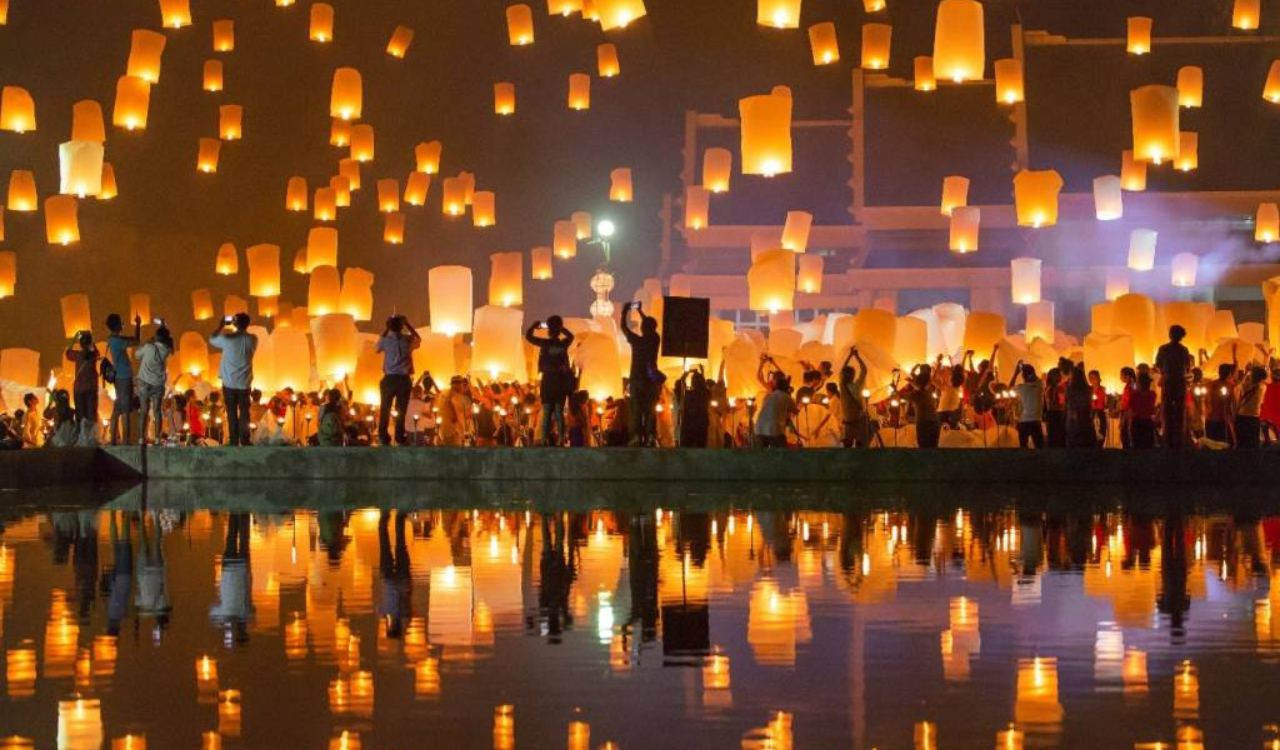
Yee Ping & Loi Krathong
Separate Facts from Fiction
Two of Thailand's most photographed festivals are Loi Krathong and Yee Ping, but they are also it's most misunderstood due to misnamed images and incorrect information spread from influencer to influencer.
Loi Krathong
Loi Krathong (also written Loy Krathong) is a festival celebrated across Thailand and neighboring countries with Tai peoples (China and Myanmar). It gives thanks to the Goddess of Water, Phra Mae Khongkha, for the water received during the rainy season and the bountiful crops it brings. Offerings are in the form of krathong, a lotus flower shaped float, adorned with a candle, offering coin and flowers. Locals launch these krathong on local rivers, stream, ponds, even moats around old cities.
The festival takes place on the full moon of the 12th lunar month of the Thai lunar calendar. So the festival falls on different dates each year, as with other lunar festivals and significant dates. Sometimes the Thai lunar calendar and the western full moon calendar do not coincide, due to the way nights are determined. The western calendar looks at the day as being from midnight to midnight. The Thai look at the day being from sunrise to sunrise. So if the moon is fullest at 3 am on 21 November, the western calendar will note it as being on 21 November, but the Thais will mark it as being on 20 November.
Yee Ping
Yee Ping (also written as Yi Peng) was a Lanna Festival, Lanna being the former northern Lanna Kingdom covering the areas of modern day Chiang Mai and Chiang Rai. Yee Ping is often referred to as the Lantern Festival as people hang lanterns outside their houses and along village streets. The locals launch khom loi (fire lanterns, sky lanterns) to make merit for their ancestors. Yee Ping takes place on the full moon of the 2nd lunar month of the Lanna calendar, which happens to be the same as the 12th month of the Thai Lunar calendar.
Lanna Khatina
Now for the culprit of confusion. Lanna Khatina was a religious ceremony held on temple grounds behind Mae Jo University. It was put on by a rather flamboyant Dharma Sect of Buddhism and took place a couple of weeks before the full moon. This ceremony was a long session of chanting and prayers followed by a mass release of khom loi. Photos of the mass launch of khom loi started circulating and slowly more and more tourists came to watch the ceremony. Sadly many of those images and blog posts were mislabeled as Yee Ping.
Realizing there was profit to be made, the religious ceremony started charging money to attend, with tickets ranging from US$100 to US$300 and moved the dates to coincide with the full moon. More organizations jumped on the gravy train, starting competing events and sadly continued to mislabel their events as "official" Yee Ping festivals.
So to set the record straight, there are no costs to attend the Loi Krathong and Yee Ping festivals. Any tickets are for overpriced tourist shows NOT the festivals.
Where to Enjoy the Festivals
As mentioned early on, Loi Krathong is celebrated all across Thailand. Everywhere, from big cities to tiny villages have some form of celebration on the full moon night. Small villages may build a bamboo platform by the local river for villagers to launch their krathong. Big cities like Bangkok will have designated bodies of water to launch your krathong, as well as along the river.
Two of the best locations for the festival are Sukhothai Historical Park and Chiang Mai. Sukhothai Historical Park puts on a big sound and light show in among the ruins, with actors, mock historical battles replete with elephants and horses. Sukhothai is also where the Royal Family sends their krathong offering.
Chiang Mai is world renowned for the events, as they celebrate both festivals. If you go by the Ping River, you will be dazzled by thousands of khom loi floating in the skies overhead and thousands of krathong tinkling as they float down the river. Festivities in both locations last for three to five days.
Eco Friendly
Finally, a note on the environmental costs. Often folks mistakenly complain that the events ruin the environment. Khom loi in Thailand are made from very basic materials, tissue paper, bamboo strips, candle wax, toilet paper and two small pieces of steel wire. In cities teams of cleaners head out in the early hours to collect all the khom loi that have floated back to earth, though some do end up in the forests. Fortunately everything left is biodegradable, even the steel wire oxidizes away quickly in Thailand's humid environment.
The krathong are also biodegradable, with the float underneath being made from slices of the stalks of bananas and all the decorations being leaves and flowers. And like with the khom loi, teams head out the morning after to clear them off the water's surfaces.
Discover Thailand from a Local's Perspective
Pedalers has been offering Thailand bicycle tours since 1987 and have gained an in-depth knowledge of the country, its history, culture and cuisine. Join our knowledgeable cycling guides and discover this wonderful country from a locals point of view.


 PEDALERS
PEDALERS